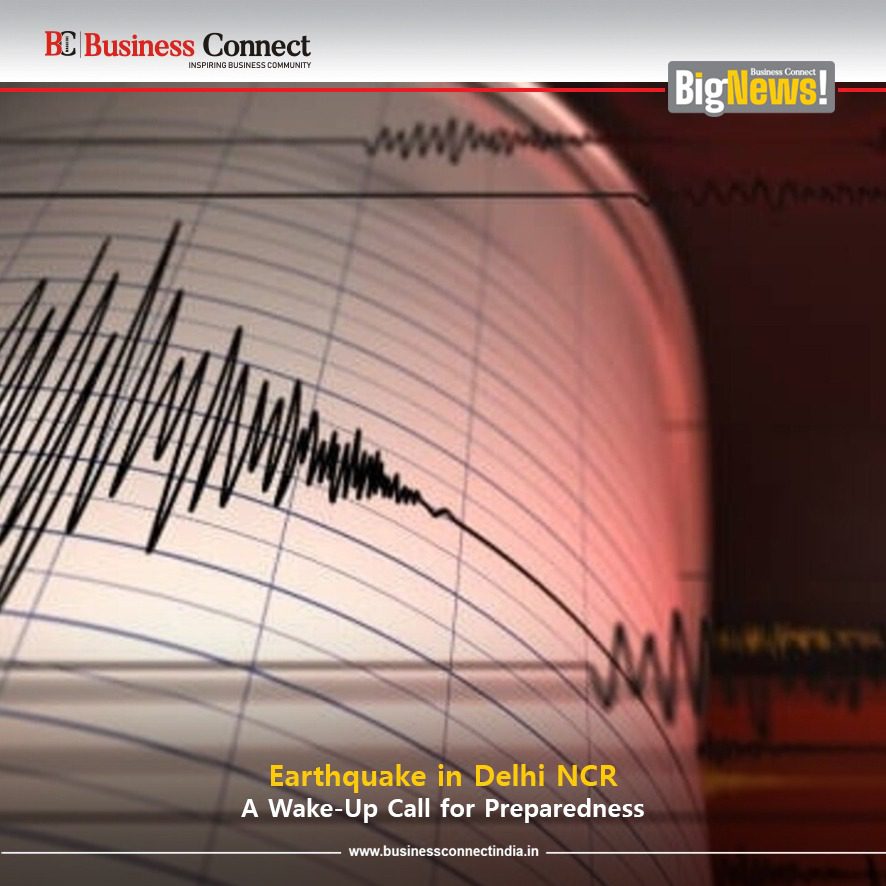Earthquake in Delhi NCR: A Wake-Up Call for Preparedness
By Business Connect Magazine | Published: July 10, 2025
On the morning of July 10, 2025, at approximately 9:04 AM IST, residents of Delhi NCR were jolted by mild tremors, marking yet another seismic event in the region. According to the National Centre for Seismology (NCS), the earthquake registered a magnitude of 3.2 on the Richter scale, with its epicenter located in the southeast part of Delhi, at a shallow depth of 5 kilometers. While no significant damage or casualties have been reported, the event has reignited discussions about Delhi’s vulnerability to earthquakes and the urgent need for robust preparedness measures.
A Region Prone to Seismic Activity
Delhi NCR lies in Seismic Zone IV, the second-highest risk category in India’s seismic zoning map, making it prone to moderate-to-strong earthquakes. The region’s proximity to the Himalayan collision zone, approximately 250 kilometers away, combined with local fault lines such as the Delhi-Haridwar Ridge and the Mahendragarh-Dehradun fault, contributes to its seismic susceptibility. Historically, Delhi has experienced earthquakes ranging from 5-6 magnitude, with occasional events reaching 6-7 or even 7-8, as noted by the Delhi Disaster Management Authority (DDMA).
The latest quake, though minor, follows a pattern of seismic activity in the region. Earlier this year, on February 17, 2025, a 4.0-magnitude earthquake struck Delhi NCR, with its epicenter near Durgabai Deshmukh College in Dhaula Kuan. That event, also at a shallow depth of 5 kilometers, caused strong tremors felt across Delhi, Noida, Greater Noida, and Ghaziabad, prompting residents to evacuate high-rise buildings. Similarly, a 2.3-magnitude quake hit South East Delhi on June 8, 2025, again with no reported damage.
Why This Earthquake Felt Significant
Despite its relatively low magnitude, the July 10 earthquake was noticeable due to its shallow depth and urban setting. Shallow earthquakes, occurring close to the Earth’s surface, tend to produce stronger shaking compared to deeper quakes. The soft alluvial soil in parts of Delhi, particularly along the Yamuna River and its floodplains, can amplify seismic waves, intensifying the tremors. Additionally, the dense concentration of high-rise buildings in Delhi NCR, especially in areas like Noida and Ghaziabad, makes structures more susceptible to swaying, heightening the perceived intensity.
Social media platforms, particularly X, buzzed with reactions from residents. Posts described the brief but unsettling tremors, with some users humorously noting they were woken up “without an alarm.” Others expressed concern about the frequency of such events, calling for better infrastructure resilience.
Economic and Structural Implications
Delhi NCR, a major commercial and industrial hub, faces significant economic risks from seismic activity. The DDMA highlights that an earthquake in the capital could have far-reaching implications, not just locally but across the country, given Delhi’s role as a political and economic center. High-risk areas like Connaught Place, the walled city, and trans-Yamuna regions, characterized by high-rise buildings and unplanned settlements, are particularly vulnerable due to substandard construction and high population density.
The region’s aging infrastructure exacerbates these risks. Over 60% of Delhi’s buildings are more than two decades old, and over 75% of constructions in municipal areas fail to comply with building regulations, including those in over 1,799 unauthorized colonies. This underscores the need for seismic retrofitting and stricter adherence to updated building codes, particularly for critical infrastructure like bridges and public facilities.
Business Continuity and Preparedness
For businesses operating in Delhi NCR, earthquakes pose a significant threat to operations, supply chains, and employee safety. The February 17 quake, for instance, disrupted morning routines, with employees in high-rise offices rushing to evacuate. Such events highlight the importance of robust business continuity plans (BCPs). Companies must prioritize:
Structural Audits: Regular assessments of office buildings to ensure compliance with seismic codes, such as IS:1893-2016, which outlines criteria for earthquake-resistant design.
Emergency Protocols: Implementing “Drop, Cover, and Hold On” drills and maintaining clear evacuation routes to ensure employee safety.
Data and Asset Protection: Securing critical IT infrastructure and sensitive equipment to prevent losses during seismic events.
Community Engagement: Collaborating with local authorities and the DDMA to support community-wide preparedness initiatives.
Government and Community Response
Following the February 17 earthquake, Prime Minister Narendra Modi urged residents to remain calm and follow safety precautions, with authorities closely monitoring for aftershocks. The Delhi Police also activated emergency helplines, such as 112, to assist citizens. Similar measures were likely in place for the July 10 event, with the NCS and other agencies keeping a close watch.
Experts, including Dr. OP Mishra, Director of the NCS, have emphasized that while Delhi experiences minor quakes periodically, the risk of a larger event cannot be ruled out. Seismologist Ajay Paul noted that the February quake might have been a pre-shock, hinting at the possibility of a stronger main shock in the future. This underscores the need for proactive measures, including public awareness campaigns and investment in earthquake-resistant infrastructure.
A Call to Action
The July 10, 2025, earthquake, though minor, serves as a reminder of Delhi NCR’s seismic vulnerability. Businesses, residents, and policymakers must work together to mitigate risks. For the corporate sector, this means investing in resilient infrastructure and preparedness training. For the government, it involves enforcing stricter building codes and retrofitting existing structures. For residents, adopting coping mechanisms and staying mentally prepared are critical, as earthquakes remain unpredictable.
As Delhi continues to grow as a global business hub, ensuring seismic resilience is not just a necessity but a strategic imperative. By prioritizing preparedness, the region can safeguard lives, protect economic stability, and build a future resilient to the forces of nature.
For more updates on Delhi NCR’s seismic activity and business resilience strategies, stay tuned to Business Connect Magazine.



